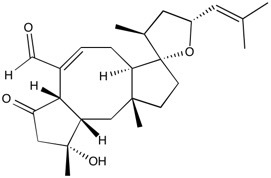Ophiobolin A | Autophagy inducer / Anticancer
NMR (Conforms)

Available Options
| Size: | Price | Quantity | |
|---|---|---|---|
| 200 µg | $60.00 | ||
| 1 mg | $200.00 |
Ophiobolin A (4611-05-6) selectively inhibits the growth of cancer cells (IC50=0.4-4.3 μM) over normal cells (IC50=20.9 μM).1 Induces non-apoptotic cell death in glioblastoma cells and is active in an in vivo model.2 Covalently reacts with primary amines such as lysine side chains2 and phosphatidylethanolamine3 forming unique pyrrole adducts. Induces ER stress4, paraptosis4 and autophagy5. Ophiobolin A activated mitochondrial respiration in a COX5A- and HIGD2A-dependent manner, leading to mitochondrial oxidative stress and rapid cell death in cancer cells.6
References/Citations:
1) Bhatia et al. (2016), Anticancer activity of Ophiobolin A, isolated from the endophytic fungus Bipolaris setariae; Nat. Prod. Res., 30 1455
2) Dasari et al. (2015), Fungal metabolite ophiobolin A as a promising anti-glioma agent: In vivo evaluation, structure-activity relationship and unique pyrrolylation of primary amines; Bioorg. Med. Chem. Lett., 25 4544
3) Chidley et al. (2016), The anticancer natural product ophiobolin A induces cytotoxicity by covalent modification of phosphatidylethanolamine; Elife., 5 e14601
4) Kim et al. (2017), Ophiobolin A kills human glioblastoma cells by inducing endoplasmic reticulum stress via disruption of thiol proteostatis; Oncotarget, 8 106740
5) Rodolfo et al. (2016), Ophiobolin A Induces Autophagy and Activates the Mitochondrial Pathway of Apoptosis in Human Melanoma Cells; PLoS One, 11 e0167672
6) Gowans et al. (2024), Ophiobolin A Covalently Targets Mitochondrial Complex IV Leading to Metabolic Collapse in Cancer Cells; ACS Chem. Biol., 19 1260
NMR (Conforms)
Safety Data Sheet:
Product Data Sheet:
Materials provided by Focus Biomolecules are for laboratory research use only and are not intended for human or veterinary applications. Please note that we do not sell to individuals and that all orders placed by non-research organizations will incur a $20 restocking/refund fee
Ophiobolin A (4611-05-6) selectively inhibits the growth of cancer cells (IC50=0.4-4.3 μM) over normal cells (IC50=20.9 μM).1 Induces non-apoptotic cell death in glioblastoma cells and is active in an in vivo model.2 Covalently reacts with primary amines such as lysine side chains2 and phosphatidylethanolamine3 forming unique pyrrole adducts. Induces ER stress4, paraptosis4 and autophagy5. Ophiobolin A activated mitochondrial respiration in a COX5A- and HIGD2A-dependent manner, leading to mitochondrial oxidative stress and rapid cell death in cancer cells.6
References/Citations:
1) Bhatia et al. (2016), Anticancer activity of Ophiobolin A, isolated from the endophytic fungus Bipolaris setariae; Nat. Prod. Res., 30 1455
2) Dasari et al. (2015), Fungal metabolite ophiobolin A as a promising anti-glioma agent: In vivo evaluation, structure-activity relationship and unique pyrrolylation of primary amines; Bioorg. Med. Chem. Lett., 25 4544
3) Chidley et al. (2016), The anticancer natural product ophiobolin A induces cytotoxicity by covalent modification of phosphatidylethanolamine; Elife., 5 e14601
4) Kim et al. (2017), Ophiobolin A kills human glioblastoma cells by inducing endoplasmic reticulum stress via disruption of thiol proteostatis; Oncotarget, 8 106740
5) Rodolfo et al. (2016), Ophiobolin A Induces Autophagy and Activates the Mitochondrial Pathway of Apoptosis in Human Melanoma Cells; PLoS One, 11 e0167672
6) Gowans et al. (2024), Ophiobolin A Covalently Targets Mitochondrial Complex IV Leading to Metabolic Collapse in Cancer Cells; ACS Chem. Biol., 19 1260
Related Calcium Signaling Products
Download
Calculate the molar concentration, mass or volume in a solution.
Concentration × Volume × Molecular Weight = Mass
Focus Biomolecules • Plymouth Meeting, PA USA • 1-855-FOCUS21
Focus Biomolecules
Plymouth Meeting, PA USA
1-855-FOCUS21
Website Created by Advanta Advertising LLC.

